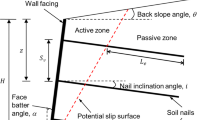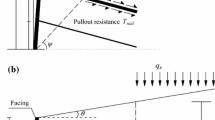Abstract
Statistical evaluation of the accuracy of effective stress method (ESM) equations for prediction of the ultimate bond strength of soil nails was performed using the maximum likelihood method. Over 500 pullout tests were examined for soil nails installed in two different Hong Kong soils. The data were parsed into tests that reached pullout failure before reaching 90% of the nail tendon yield strength (uncensored data) and tests terminated at the 90% yield strength criterion (censored data). A log-likelihood function was constructed to include both types of bias data, where bias is the ratio of measured to predicted ultimate nail bond strength. The accuracy of two ESM equations previously reported in the literature was evaluated using both uncensored data alone and then combined censored and uncensored data. A revised ESM equation with two empirical coefficients is calibrated using the larger combined data sets, and its accuracy is compared to the two earlier formulations using the same expanded database. The revised formulation has the advantage that mean of bias values is 1 for both soil types and there are no bias dependencies with magnitude of predicted pullout capacity or overburden pressure. However, for one soil type the COV of bias values is less using the larger database and for the other soil type the value is greater. A practical lesson for calibration of equations of the type investigated here is that including censored data for calibration is of great importance to reach a better and more thorough understanding of the performance of the model.














Similar content being viewed by others
References
Ang AHS, Tang WH (2007) Probability concepts in engineering: emphasis on applications to civil and environmental engineering, vol 1, 2nd edn. Wiley, New York
Babu SGL, Singh VP (2011) Reliability-based load and resistance factors for soil-nail walls. Can Geotech J 48(6):915–930
Beck JV, Arnold KJ (1977) Parameter estimation in engineering and science. Wiley, New York
Cadden A, Gomez J, Baxter A, Bird T (2010) Hollow bar soil nails pullout test program. In: Report No. FHWA-CFL/TD-10-001, Central Federal Lands Highway Division, Federal Highway Administration, Lakewood
Cartier G, Gigan JP (1983) Experiments and observations in soil nailing structures. In: Proceeding of the 8th European conference on soil mechanics and foundation engineering, Helsinki, pp 473–476
Casella G, Berger RL (2001) Statistical inference, 2nd edn. Pacific Grove, Duxbury
Cheung RWM, Shum KW (2012) Review of the approach for estimation of pullout resistance of soil nails. In: GEO Report No. 264, Geotechnical Engineering Office (GEO), Civil Engineering and Development Department, the Government of the Hong Kong Special Administrative Region
Chu LM, Yin JH (2005) Comparison of interface shear strength of soil nails measured by both direct shear box tests and pullout tests. J Geotech Geoenviron Eng 131(9):1097–1107
Edwards AWF (1972) Likelihood. Cambridge University Press, Cambridge
GCO (1988) Geoguide 3: Guide to rock and soil descriptions. Geotechnical Control Office (GCO), Public Works Department of Hong Kong, Hong Kong
Gens A, Ledesma A, Alonso EE (1996) Estimation of parameters in geotechnical back analysis-II. Application to a tunnel excavation problem. Comput Geotech 18(1):29–46
Geotechnical Engineering Office (GEO) (2008) Geoguide 7: guide to soil nail design and construction. In: GEO Report No. 197, Civil Engineering and Development Department, Government of the Hong Kong Special Administrative Region, Hong Kong
Hong CY, Yin JH, Pei HF, Zhou WH (2013) Experimental study on the pullout resistance of pressure-grouted soil nails in the field. Can Geotech J 50(7):693–704
Juang CH, Ching JY, Wang L, Khoshnevisan S, Ku CS (2013) Simplified procedure for estimation of liquefaction-induced settlement and site-specific probabilistic settlement exceedance curve using cone penetration test (CPT). Can Geotech J 50(10):1055–1066
Juang CH, Khoshnevisan S, Zhang J (2014) Chapter 4: Maximum likelihood principle and its application in soil liquefaction assessment. In: Phoon KK, Ching J (eds) Risk and reliability in geotechnical engineering. CRC Press, Boca Raton, pp 181–220
Lazarte CA, Robinson H, Gómez JE, Baxter A, Cadden A, Berg R (2015) Geotechnical engineering circular No. 7 soil nail walls-reference manual. In: Report FHWA-NHI-14-007, Federal Highway Administration, FHWA, Washington
Ledesma A, Gens A, Alonso EE (1996) Estimation of parameters in geotechnical back analysis-I. Maximum likelihood approach. Comput Geotech 18(1):1–27
Ledesma A, Gens A, Alonso EE (1996) Parameter and variance estimation in geotechnical back analysis using prior information. Int J Numer Anal Methods Geomech 20:114–141
Li J, Tham LG, Junaideen SM, Yue ZQ, Lee CF (2008) Loose fill slope stabilization with soil nails: full-scale test. J Geotech Geoenviron Eng 134(3):277–288
Lin P, Bathurst RJ (2018) Reliability-based internal limit states design of soil nails using different load and resistance models. J Geotech Geoenviron Eng 144(5):04018022
Lin P, Bathurst RJ (2019) Calibration of resistance factors for load and resistance factor design of internal limit states of soil nail walls. J Geotech Geoenviron Eng 145(1):04018100
Lin P, Liu J (2017) Analysis of resistance factors for LRFD of soil nail walls against external stability failures. Acta Geotech 12(1):157–169
Lin P, Bathurst RJ, Javankhoshdel S, Liu J (2017) Statistical analysis of the effective stress method and modifications for prediction of ultimate bond strength of soil nails. Acta Geotech 12(1):171–182
Lin P, Bathurst RJ, Liu J (2017) Statistical evaluation of the FHWA simplified method and modifications for predicting soil nail loads. J Geotech Geoenviron Eng 143(1):04016107
Millar RB (2011) Maximum likelihood estimation and inference: with examples in R, SAS and ADMB. Wiley, Hoboken
Ng WWC, Pang YW (2000) Experimental investigations of the soil-water characteristics of a volcanic soil. Can Geotech J 37(12):1252–1264
Nowak AS, Collins KR (2012) Reliability of structures, 2nd edn. CRC Press, Boca Raton
Phear A, Dew C, Ozsoy B, Wharmby NJ, Judge J, Barley AD (2005) Soil nailing-best practice guidance. CIRIA C637, London
Pradhan B, Tham LG, Yue ZQ, Junaideen SM, Lee CF (2006) Soil-nail pullout interaction in loose fill materials. Int J Geomech 6(4):238–247
Sabatini PJ, Pass DG, Bachus RC (1999) Ground anchors and anchored systems. In: Geotechnical engineering circular No. 4, Report No. FHWA-IF-99-015, Federal Highway Administration, Washington
Sabatini PJ, Tanyu B, Armour T, Groneck P, Keeley J (2005) Micropile design and construction. Reference manual for NHI course 132078. In: Report No. FHWA-NHI-05-039, Federal Highway Administration, Washington
Sah NK, Sheorey PR, Upadhyaya LN (1994) Maximum likelihood estimation of slope stability. Int J Rock Mech Min Sci Geomech Abstr 31(1):47–53
Schlosser F, Guilloux A (1981) Le frottement dans les sols. Rev Fr Géotech 16:65–77
Wang DY (2002) Development of a method for model calibration with non-normal data. Ph.D. thesis, The University of Texas at Austin, Austin
Watkins AT, Powell GE (1992) Soil nailing to existing slopes as landslip preventive works. Hong Kong Eng 20(3):20–27
Ye X, Wang Q, Wang S et al (2018) Performance of a compaction-grouted soil nail in laboratory tests. Acta Geotech. https://doi.org/10.1007/s11440-018-0693-y
Ye X, Wang S, Wang Q et al (2018) The influence of the degree of saturation on compaction-grouted soil nails in sand. Acta Geotech. https://doi.org/10.1007/s11440-018-0706-x
Yin JH, Su LJ, Cheung RWM, Shiu YK, Tang C (2009) The influence of grouting pressure on the pullout resistance of a soil nails in compacted completely decomposed granite fill. Géotechnique 59(2):103–113
Yuan J, Lin P (2018) Reliability analysis of soil nail internal limit states using default FHWA load and resistance models. Mar Georesour Geotechnol. https://doi.org/10.1080/1064119X.2018.1489920
Zevgolis IE, Daffas ZA (2018) System reliability assessment of soil nail walls. Comput Geotech 98(6):232–242
Zhang G, Robertson PK, Brachman RWI (2002) Estimating liquefaction-induced ground settlements from CPT for level ground. Can Geotech J 39(5):1168–1180
Zhang LL, Zhang LM, Tang WH (2009) Uncertainties of field pullout resistance of soil nails. J Geotech Geoenviron Eng 135(7):966–972
Zhou WH (2009) Experimental and theoretical study on pullout resistance of grouted soil nails. Ph.D. thesis, The Hong Kong Polytechnic University, Hong Kong
Acknowledgements
Financial support for this study was provided by Research Starting Fund by Sun Yat-Sen University, China, and the Natural Sciences and Engineering Research Council of Canada (NSERC) Engage Program.
Author information
Authors and Affiliations
Corresponding author
Additional information
Publisher's Note
Springer Nature remains neutral with regard to jurisdictional claims in published maps and institutional affiliations.
Electronic supplementary material
Below is the link to the electronic supplementary material.
Rights and permissions
About this article
Cite this article
Lin, P., Liu, J. Evaluation and calibration of ultimate bond strength models for soil nails using maximum likelihood method. Acta Geotech. 15, 1993–2015 (2020). https://doi.org/10.1007/s11440-019-00883-x
Received:
Accepted:
Published:
Issue Date:
DOI: https://doi.org/10.1007/s11440-019-00883-x




